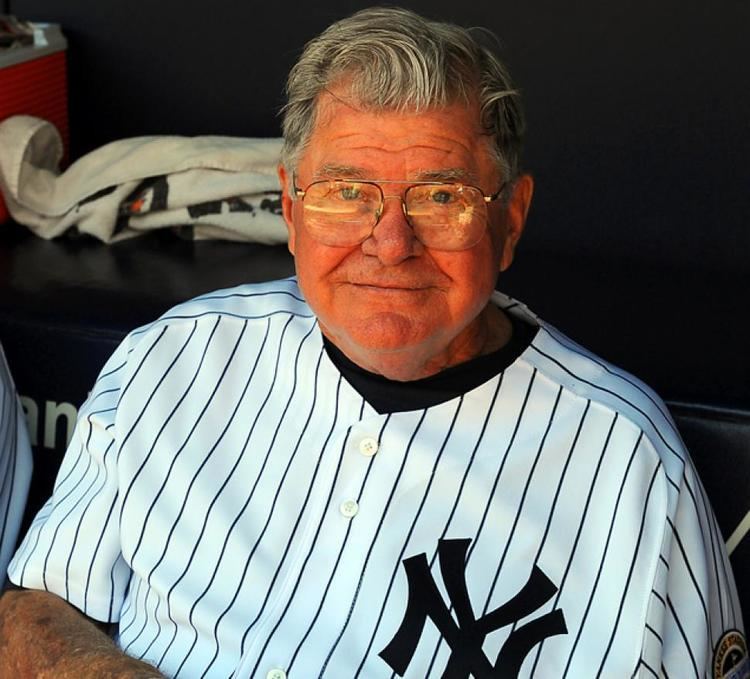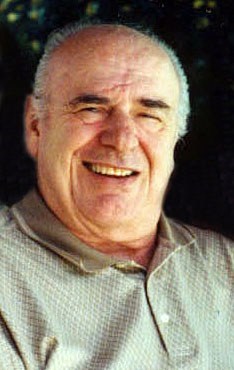In a weird coincidence, "Bullet Bob" Turley died just a few days after Virgil Trucks. They were the opposing pitchers in the 1st home game the Orioles ever played, at Memorial Stadium in 1954, with Turley outpitching the Chicago White Sox' Trucks, and the O's winning 3-1.
After that season, on November 17, 1954, the Yanks and O's made the biggest trade in baseball history, 18 players. Of note were the Yankees sending Darrell Johnson, who would manage the Boston Red Sox to their 1975 Pennant and become the Seattle Mariners' 1st manager in 1977, and getting Billy Hunter, who would become a longtime Oriole coach and the Texas Rangers' manager in 1977.
The most notable players the Yankees gave up were Triandos, was All-Star left fielder Gene Woodling, and catcher Hal Smith, which would come back to bite them when Smith hit a home run in Game 7 of the 1960 World Series, setting up Bill Mazeroski's more famous homer. The most notable player the Orioles gave up, aside from Turley, was Don Larsen.
Robert Lee Turley was born on September 19, 1930 in Troy, Illinois, about 20 miles northeast of St. Louis, and reached the majors with his "hometown" St. Louis Browns, shortly after his 21st birthday, on September 29, 1951. He was the losing pitcher in the Browns' 8-3 loss to the White Sox at Sportsman's Park.
He missed all of the 1952 season and most of 1953 due to serving in the Korean War, and moved with the Browns to Baltimore as they became the Orioles in 1954. As his nickname "Bullet Bob" suggests, he had a blazing fastball, but he required some control: In '54, he led the American League in strikeouts, but also in walks, and in most hits given up per 9 innings pitched.
After that 1st season in Baltimore, the Orioles hired former big-league catcher Paul Richards, the losing manager for the White Sox in that Memorial Stadium opener, to be both their new manager and their new general manager. Known for his handling of pitchers and his Texas hometown as "the Wizard of Waxahachie," he decided Turley wasn't worth the effort -- and neither was Larsen, who was so wild on and off the field he was known as "Gooney Bird" -- and put them both in the huge trade.
But Yankee manager Casey Stengel and pitching coach Jim Turner figured out how to handle them, and it paid off big-time. Larsen went from 3-21 in '54 to 9-2 in '55, raising his ERA+ (not that anyone knew that statistic at the time) from a dismal 82 to a strong 123. Turley went from 14-15 and 104 to 17-13 and 123. He would still lead the AL in walks in '55 and '58, but his control improved.
Turley wore Number 19 with the Yankees, and was a member of their 4 straight Pennant winners in 1955-58, including their World Series winners in 1956 and '58. In 1958, he went 21-7, leading the AL in wins, winning percentage and complete games, and while he led in walks with 128, it was over 50 less than his peak, and he also struck out 168 batters, a high total for the time. The Cy Young Award had been established in 1956, and Turley became the 1st Yankee to win it. That's a good trivia question: The average fan might think it was Whitey Ford who was the 1st in Pinstripes to win it.
Turley's annus mirabilis continued in the World Series, as the Yankees looked for revenge against the team that had beaten them in the Series the year before, the Milwaukee Braves. Although he was shelled by Hank Aaron, Eddie Mathews and company in the 1st inning of Game 2, and the Yankees fell behind 3 games to 1, Turley pitched a 5-hit shutout in Game 5, pitched the 10th inning to get a save in Game 6, and relieved Larsen in the 3rd inning of Game 7, despite not quite having 2 days' rest, and got the win again, as the Yankees regained the crown. Turley was named Series MVP -- making him the 1st pitcher to win the Babe Ruth Award and the Cy Young Award in the same season.
He was also a member of the World Championship teams of 1961 and 1962, so that's 4 rings. But by that point, injuries had begun to do him in. And after the 1962 season, the Yankees sold him to the Los Angeles Angels. In the middle of the following season, he was released, and then signed by the Red Sox, but they released him at the end of the season.
He became a representative of Primerica Financial Services, making more money with them than he did on the Yankees, whose general manager George Weiss was more interested in making money than making Pennants. Turley retired to the Atlanta suburbs, and died of liver cancer there this past Saturday. Until recently, he had been making regular appearances at Yankee Stadium, old and new, on Old-Timers' Day, and was also a guest at the opening of the new Stadium in 2009.
*
As for Triandos: He was born on July 30, 1930, 51 days before Turley, in San Francisco -- and Baseball Reference has no name for him other than "Gus Triandos," when, at that time, a son of Greek immigrants might have been nicknamed Gus, but he wouldn't have been born with such a short name.
The Yankees signed him as a free agent in 1948, thus preventing him from playing college ball, though he still graduated from St. Mary's College outside Oakland. Serving in the Korean War kept him out of most of the 1951 season, all of 1952, and the start of 1953. But upon his discharge, he batted .368 with 19 home runs with the Birmingham Barons of the Double-A Southern Association.
He made his major league debut on August 3, 1953, at the original Yankee Stadium. Ironically, it was against the Browns, soon to be the Orioles, the team for which he's best known. The Yankees won, 11-3, with Whitey Ford pitching a complete game and going 4-for-5 at bat. Wearing Number 26, Triandos started at 1st base and batted 6th, and went 1-for-5. Mickey Mantle and Hank Bauer each had 3 RBIs. Because it was a Monday afternoon game, attendance was only 7,117.
He played 18 games that season, but did not make the World Series roster. The Yankees kept him with the Kansas City Blues of the Triple-A American Association -- soon to be replaced by the moved Philadelphia Athletics -- for all but 2 games in 1954.
The Yankees then had Yogi Berra, and had Elston Howard coming up -- which is also why backup catcher Ralph Houk retired and went into coaching, and a career that would see him manage the Yankees, the Tigers and the Boston Red Sox. And 1st base was manned by veteran Joe Collins and the rookie Bill "Moose" Skowron. There really wasn't a place for Gus in The Bronx.
Plus, as a right-handed hitter, Triandos was hitting into the "Death Valley" left and center field of the pre-renovation old Stadium: The left field pole was marked as being just 301 feet from home plate, but straightaway left was 402, a sign near the visiting team's bullpen said 415, left-center was 457 and straightaway center was 461. (In contrast, the right field pole was 296 feet, and straightaway right was 344, before the distances began to get ridiculous again, as right-center was 407.)
Thus, Triandos was expendable, and so he was thrown into that massive trade. From 1955 to 1962, he was the Orioles' regular catcher, and was also the starter for the Detroit Tigers when he was traded there in 1963.
As with Turley, his best year was 1958: Although he batted just .245, he hit 30 home runs and had 79 RBIs. It's worth noting that Memorial Stadium was a park heavily advantaged toward pitchers at the time, and while this would be reduced in the 1980s, it never really favored hitters. He made 3 American League All-Star teams, and when the All-Star Game was held at Memorial in 1958, he caught Turley for an inning.
He was a key cog as the Orioles got into their 1st Pennant race in 1960. They won 89 games, and were tied for 1st place as late as September 14. This included a 3-game sweep of the Yankees in Baltimore at the start of September, a series they still talk about in Charm City, capping an 11-1 run of games. But on the 15th, they went into Yankee Stadium and got swept in 4 straight, with 3 of the games behig close, and the Yankees ended up 8 games ahead of them.
At the time, power-hitting catchers were rare, but Triandos was one. He was the Orioles' representative on the 1960 TV series Home Run Derby. There are now 7 players from that series still alive: Hank Aaron, Ernie Banks, Bob Cerv, Rocky Colavito, Al Kaline, Willie Mays and Frank Robinson.
He was also regarded as a good defensive catcher. He had to be, as the Orioles then had Hoyt Wilhelm, his generation's master of the trickiest legal pitch in the game, the knuckleball. Triandos used an oversize mitt to catcher Wilhelm's flutter, one that would later be banned.
The Wilhelm/Triandos mitt, and a standard catcher's mitt
Although best remembered as a great reliever -- he was the 1st man to pitch in over 1,000 games and the 1st reliever elected to the Hall of Fame, and has the lowest career ERA of any retired pitcher in the post-1920 Lively Ball Era (he's at 2.52, but Mariano Rivera is at 2.21 and will break that "record" when he retires) -- Wilhelm started a few games.
One was on September 20, 1958, with Triandos as his catcher, pitched a no-hitter against the Yankees. The Orioles only won 1-0, and Wilhelm walked 2 batters to prevent a perfect game, so, especially with the knuckleball, Triandos had to guard against wild pitchers and passed balls to save the win. He did, so while he didn't have to call pitches, due to Wilhelm really only having the one pitch, the achievement is nearly as much Triandos' as Wilhelm's.
While 6 Houston Astros combined to toss a gem against the Yankees in 2003, Wilhelm remains the last single pitcher to throw a no-hitter against the Yankees.
Another mark of Triandos' defense was that, in 1961, the biggest base-stealing threat in the American League, Chicago White Sox shortstop Luis Aparicio, rated him as the 2nd-toughest catcher to steal on in the AL, behind only Earl Battey of the Minnesota Twins.
In 1964, Triandos was traded to the Philadelphia Phillies, and was a member of that star-crossed team that blew a 6 1/2-game lead with only 12 to play and threw away a sure National League Pennant. A major problem for that team is that they never settled on a decent catcher: Triandos played 64 games behind the plate, Clay Dalrymple 127, and they batted .250 and .238, respectively, and between them, at Connie Mack Stadium, which favored pitchers by not as much as Triandos' previous 2 home fields, they hit 14 homers and had 79 RBIs.
Both were good defensively, but they needed more stick: Johnny Callison hit 31 homers and Dick Allen 29, but the rest of the team combined only hit 70, and the team as a whole only had a .315 on-base percentage.
Triandos played out the string with the Houston Astros in 1965, and retired at age 35. He returned to the Bay Area, living in San Jose, until he died this past Thursday.
UPDATE: Both Turley and Triandos were cremated, so there's no gravesite for either.




No comments:
Post a Comment